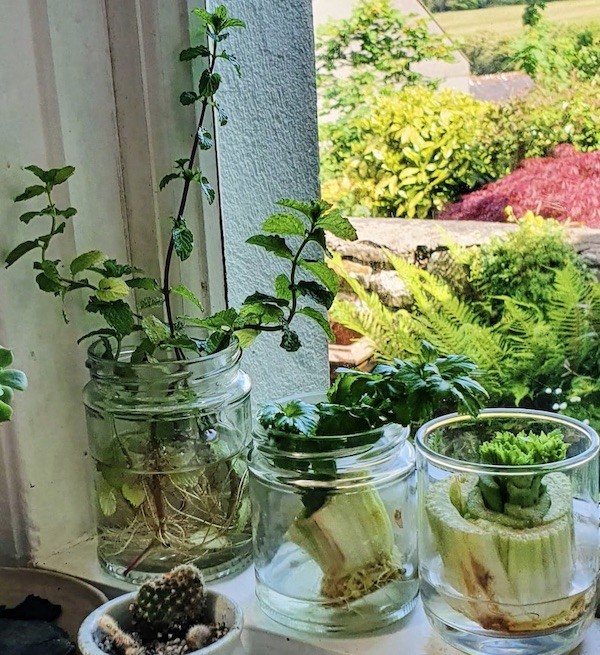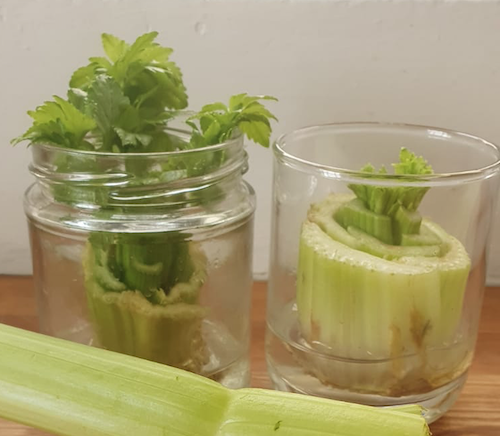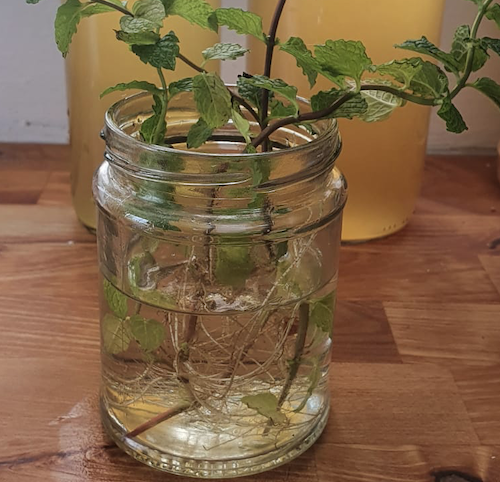Top hacks on growing fresh food for free from your leftover supermarket groceries, from gardening journalist and award winning CraftCourses tutor, Kim Stoddart.
Growing some of your own food is good for you, especially now in mainly lockdown living. It’s a positive action that we can all take to switch off from the doom and gloom outside. It’s also a viable way to put food on the table, and at the same time potentially reduce the number of supermarket trips that need to be made to the benefit of our wellbeing overall. Sticking your hands in some good honest compost and growing even a bit of fruit and vegetables for ourselves is incredibly down-to-earth empowering, nurturing and real. No wonder there has been a massive surge of green-fingered interest these past weeks.
 Growing fresh & tasty food is so satisfying
Growing fresh & tasty food is so satisfying
Sheer demand means that seeds are not always easy to come by or cheap. So, you’ll be pleased to know that there are many growing options available from leftover produce we have kicking around in our kitchens anyway.
You can grow viable plants from many of the seeds found within shop-bought produce as well as some other nifty 'hacks'. Here are some we have tried and tested, so we recommend having a go at. It's also a great way to keep the children interested and learning during Lockdown.
Our top contenders for growing plants from produce:
Pea - Dried peas can also be turned into pea shoots (great for salads) and fully fledged pea plants to grow outside.
 Pea plants grown from dried peas.
Pea plants grown from dried peas.
Grown in toilet rolls which can be planted straight into the ground.
Bean - magic beans with a lot of growing on potential. Just plant them into seed trays as you would do normally. You won’t know exactly what variety you are eating but it will most likely be tasty, fresh and good for you (full of protein). It's not too late either - there is still time this May/June to do this.
Coriander and fennel seed – just soak them overnight before sowing into seed compost for a fresh supply at your fingertips.
Chilli seeds - sew the seeds scraped from the inside of your kitchen chillies in compost, just be careful harvesting these beauties by hand because of their heat. Chilli plants do benefit from a longer growing season so are generally best sown earlier in the year but they can also make viable, edible house plants and will winter inside so this is your best option for a touch of fresh spice all year round.
Potato - the beloved spud, so versatile, tasty and filling. And can be multiplied by simply planting your sad old potatoes that are starting to chit.

Potato plants, grown from new potatoes that had started to sprout
Celery
Fresh new celery grown from old or unused shop bought stalks can be easily nurtured at home into new growth. Just place the unused base of the celery in an inch or two of fresh water (change regularly) in a sunny spot and watch the roots emerge upwards from the base. Once the regrowth looks healthy, it’s ready to plant out into multipurpose compost. Keep it in a pot inside at first and then once established move outside for your home grown supply of this staple ingredient.
 Growing fresh celery from old celery butts
Growing fresh celery from old celery butts
Mint
Mint will enhance so many dishes with it's rich fresh fragrance and new plants are easy to grow from mint trimmings. Simply place mint trimmings in fresh water and wait for the plant to grow new roots. Once you have a good set of new roots simply pot out each trimming into a small pot filled with compost and a new plant will emerge. Mojitos anyone?!
 Mint trimmings placed in water... voila new roots!
Mint trimmings placed in water... voila new roots!
Lemongrass
Quite expensive to buy, this is a lovely plant that be nurtured easily at home from any old stalks you might have previously bought. Just place the stalk(s) in a glass of water in a sunny spot and watch the roots dutifully start to emerge from the base. It’s best to change the water every few days. Once your stalk has grown some healthy-looking roots, it’s ready to plant out into multipurpose compost. Keep it in a pot inside at first and then once established over time it can placed outside for your own zesty supply of this fantastic, fresh as you can get, Thai food ingredient.
 Lemongrass stalks growing new roots in water
Lemongrass stalks growing new roots in water
Micro sprouts: beans, seeds and peas
Choose from any of the dried produce you might have kicking around at the back of your cupboard, that have been there seemingly forever. Now’s the time for that slightly dusty packet to be put to good, nourishing use. Packed full of vitamins and nutrients, most dried beans, seeds and peas can be reliably and easily transformed into delicious fresh home-grown sprouts.
Lentils, sunflower seeds, chickpeas, dried peas, mung beans, aduki beans, alfalfa and fenugreek seeds ... it will all work!
 Bring dried chickpeas to life in a home-made sprouter
Bring dried chickpeas to life in a home-made sprouter
3 simple steps:
- Choose an old glass jar to use as your sprouter, any a decent sized jar with a lid will do nicely. Make a few small holes in the lid. Job done!
- Soak whatever you are using in a jar of water overnight and rinse with fresh water the next morning. Turn the jar upside down to allow excess water to drain.
- Rinse your sprouts-to-be once a day in fresh water, taking care to drain away water. After a few days your beans, seeds or pulses will burst into life.
Once sprouted, these micro greens can be kept in the fridge in a tray and are best eaten within a few days to add delicious and healthy freshness to your meals.
Top tip:
Leftover seeds like cabbage, broccoli, or any herbs also work well for growing micro greens. Simply soak them overnight in water and then plant in compost on your windowsill in a sunny spot. Cut and come again for tasty treats to add to your salads or garnish dishes.
Kim Stoddart is a popular Guardian gardening journalist, editor of The Organic Way and award-winning CraftCourses tutor running in-person as well as live online grow-your-own gardening workshops and courses from her training gardens in West Wales. Kim has taught all over the UK from Kirsty Allsopp's Handmade Festival to the National Botanic Gardens of Wales. Kim is also the author of The Climate Change Garden Book.
Plus, if you enjoyed reading this you might like to browse through some of our other lockdown specific articles>



